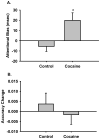Relationship between attentional bias to cocaine-related stimuli and impulsivity in cocaine-dependent subjects
- PMID: 21204739
- PMCID: PMC3110662
- DOI: 10.3109/00952990.2010.543204
Relationship between attentional bias to cocaine-related stimuli and impulsivity in cocaine-dependent subjects
Abstract
Background: Cocaine-dependent subjects show attentional bias to cocaine-related stimuli, increased impulsivity on questionnaires, and impaired inhibitory control (one component of impulsivity on behavioral tasks). However, the relationship between attentional bias, impulsivity, and inhibitory control in cocaine-dependent subjects is unknown.
Objective: To investigate the relationship between attentional bias to cocaine-related stimuli, impulsivity, and inhibitory control in cocaine dependence.
Methods: This study employed the cocaine Stroop task to measure attentional bias to cocaine-related stimuli, immediate memory task (IMT) to measure inhibitory control, and Barratt Impulsiveness Scale version 11 to measure impulsivity. Thirty-two controls and 37 cocaine-dependent subjects were recruited through newspaper advertisement.
Results: Cocaine-dependent subjects had higher attentional bias to cocaine-related words, higher scores for Barratt Impulsiveness Scale, and higher commission error rate on the IMT than controls. The attentional bias was positively correlated with the commission error rate on the IMT in the cocaine-dependent subjects but not in control subjects.
Conclusions: Cocaine-dependent subjects showed attentional bias to cocaine-related words, increased impulsivity, and poor inhibitory control compared with controls. The attentional bias was associated with inhibitory control in cocaine-dependent subjects but not in control subjects.
Scientific significance: Our findings suggest that cocaine-dependent subjects with poor inhibitory control may show higher attentional bias to cocaine-related words compared with controls and those with better inhibitory control.
Copyright © Informa Healthcare USA, Inc.
Figures


References
-
- Williams JM, Mathews A, MacLeod C. The emotional Stroop task and psychopathology. Psychol. Bull. 1996;120(1):3–24. - PubMed
-
- Cox WM, Fadardi JS, Pothos EM. The addiction-stroop test: Theoretical considerations and procedural recommendations. Psychol Bull. 2006;132(3):443–476. - PubMed
-
- Hester R, Dixon V, Garavan H. A consistent attentional bias for drug-related material in active cocaine users across word and picture versions of the emotional Stroop task. Drug Alcohol Depend. 2006;81(3):251–257. - PubMed
-
- Vadhan NP, Carpenter KM, Copersino ML, Hart CL, Foltin RW, Nunes EV. Attentional bias towards cocaine-related stimuli: relationship to treatment-seeking for cocaine dependence. Am J Drug Alcohol Abuse. 2007;33(5):727–736. - PubMed
-
- Carpenter KM, Schreiber E, Church S, McDowell D. Drug Stroop performance: relationships with primary substance of use and treatment outcome in a drug-dependent outpatient sample. Addict Behav. 2006;31(1):174–181. - PubMed
Publication types
MeSH terms
Substances
Grants and funding
LinkOut - more resources
Full Text Sources
Medical
